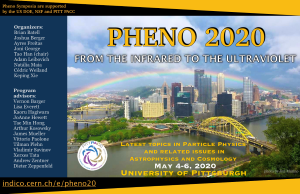Conveners
SUSY I
- Konstantin Matchev (University of Florida (US))
Supersymmetry (SUSY) provides elegant solutions to several problems in the Standard Model, and searches for SUSY particles are an important component of the LHC physics program. Naturalness arguments for weak-scale supersymmetry favour supersymmetric partners of the gluons and third generation quarks with masses light enough to be produced at the LHC. This talk will present the latest results...
Results are presented from the most recent searches for pairs of supersymmetric top quarks with the CMS detector. The searches are performed in the in final states with and without leptons benefitting from the tagging of hadronically decayed boosted W or top quarks wherever applicable. The results are based on proton-proton collisions recorded at sqrt(s) = 13 TeV with the CMS detector using...
The direct production of electroweak SUSY particles, including sleptons, charginos, and neutralinos, is a particularly interesting area with connections to dark matter and the naturalness of the Higgs mass. The small production cross sections lead to difficult searches, despite relatively clean final states.The ATLAS experiment is exploring this experimentally challenging frontier with the...
Recent LHC Run 2 limits on SUSY particles and null WIMP search results lead some to believe that SUSY is largely excluded save for some remote regions of parameter space. This ignores several developments in the past 20 years, including 1. the emergence of the string landscape and its solution to the cosmological constant problem, 2. the importance of the strong CP problem and the axion, 3....
The analyses over the new supersymmetric particles by the ATLAS and CMS collaborations have revealed quite sensitive and strict results, which exclusively shape the fundamental parameter space of low scale SUSY models. These analyses usually make some assumptions over the mass spectrum and particle species such as bino-like LSP neutralino, left-handed lightest stop, stau etc. Even though...
A hidden sector that kinetically mixes with the Minimal Supersymmetric Standard Model provides simple and well-motivated dark matter candidates that possess many of the properties of a traditional weakly interacting massive particle (WIMP). These supersymmetric constructions can also provide a natural explanation for why the dark matter is at the weak scale - even if it resides in a hidden...

